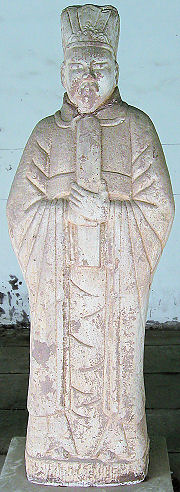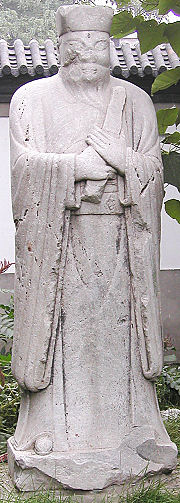
Last remains of the original Jin Dynasty city wall
This section is almost 900 years old
About 800-900 years ago the (Jürchen) Jin dominated northern China. Unusually, Jin established not one, but all of five capitals with the central one being "Zhong Du", located in what is today the southwestern part of Beijing.
Nature, time and man have however already long erased most of Jin's old central capital, but with a little perseverance one can still find a few traces almost a millennium later.
Most lie buried under meters of soil, but two large parts from the Jin dynastic central capital remain and are visible: A small section of the original wall that surrounded and protected the capital and the excavated foundation of one of the city's water gates (see next page).
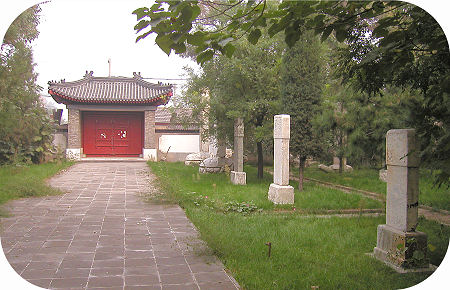
Park entrance - the path is lined with old steles
Jin was a semi-nomadic, semi-farming people from Manchuria also known as the "Rüzhen Tartars". They were breakaways from the then in North China dominating Liao dynasty, which Jin fought and eventually defeated in year 1115.
Encouraged by their success, the Jin next turned on their former allies, the Chinese Northern Song dynasty, eventually overrunning all of northern China by 1127 and in the process capturing the Northern Song capital of Kaifeng as well as most of the imperial family. The rest of the Chinese court fled south and established the Southern Song dynasty with capital in Lin'an -today's Hangzhou.
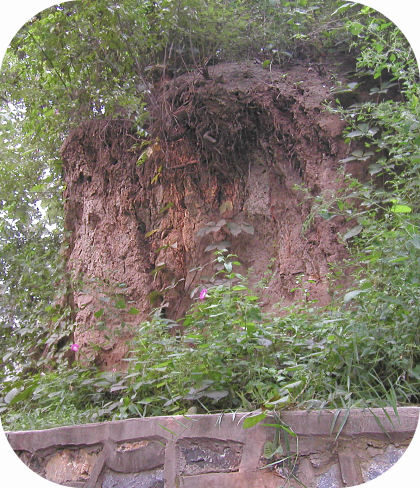
Vegetation is gradually eroding the wall
Double-crossing their former allies, the Song, ultimately cost the Jin its own very existence. When in the early 1200s a new and expanding nomadic people from the north threatened Jin, they turned to the Song suggesting an alliance. But not only did the Song refuse to join up with Jin against the new forceful enemy, Song instead seized the opportunity to initiate hostilities against Jin itself.
History would go on to record that this new enemy from the north, the Mongols, not only defeated Jin but in total irony subsequently even Southern Song. In fact, the Mongols went on to conquer the largest, contiguous expanse of land ever in world history -first under Djengis Khan and later under his grandson, Kublai Khan.
Kublai established his own Yuan dynasty with southern capital in Dadu (also today's Beijing, albeit slightly more northeastern than Jin's Zhongdu). But that's another story, let's get back to Jin and Zhongdu:
Jin's walled capital was located in the southwest part of today's Beijing because of the abundant availability of water from (today's) Liangshui River -even running directly through the city.
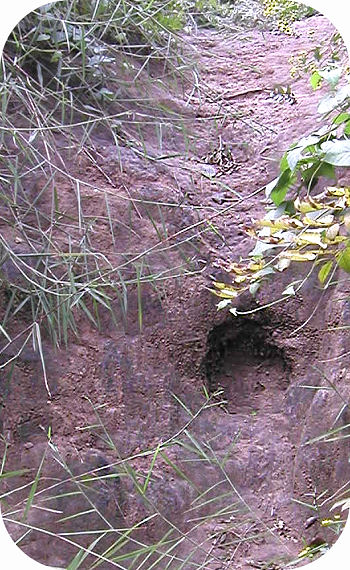
Stamped earth of the wall
is still hard as a rock after 900 years!
The wall itself was constructed using the traditional stamped earth technique, the most common wall building method for centuries in China. The earth becomes so immensely dense and compact that the wall survives for millenniums - even when fully exposed to the elements.
These photos document the last extant section of the Jin Zhongdu city wall. This short section is located inside a enwalled park in today's village of Fenghuangzui. Few people appear to be aware of this rare historic relic and hence visitors are rare. As a consequence, the entry gate is mostly locked (see picture of the locked gate from inside the park above). It is virtually impossible to find anyone who knows the gatekeeper.
The remains of the wall are merely some 20 meters long, up to 5 meters wide and about 3-4 meters high. It is overgrown by various vegetation, which is both breaking down the wall with its root network and yet also to some extent knitting it together.
The photo on the left shows the incredible robustness of a wall that is over 850 years old! Note the smoothness of the surface.
The base of this small surviving section has been protected from complete collapse by a concrete wall as can be seen from the picture at top. A plague at the front confirms that the wall section is part of the ruins of the Jin Zhongdu capital and that the protecting base wall was constructed in 1984.
This particular surviving section formed part of Zhongdu's southern outer wall, close to the western most of the three southern gates, Duanlimen (please find it on the Zhongdu map in the sidebar).
The park also contains some well preserved steles and stone sculptures of horses, worshippers and warriors, some of which are shown in the left sidebar. Apart from this there is little more of interest to see in the small park.
